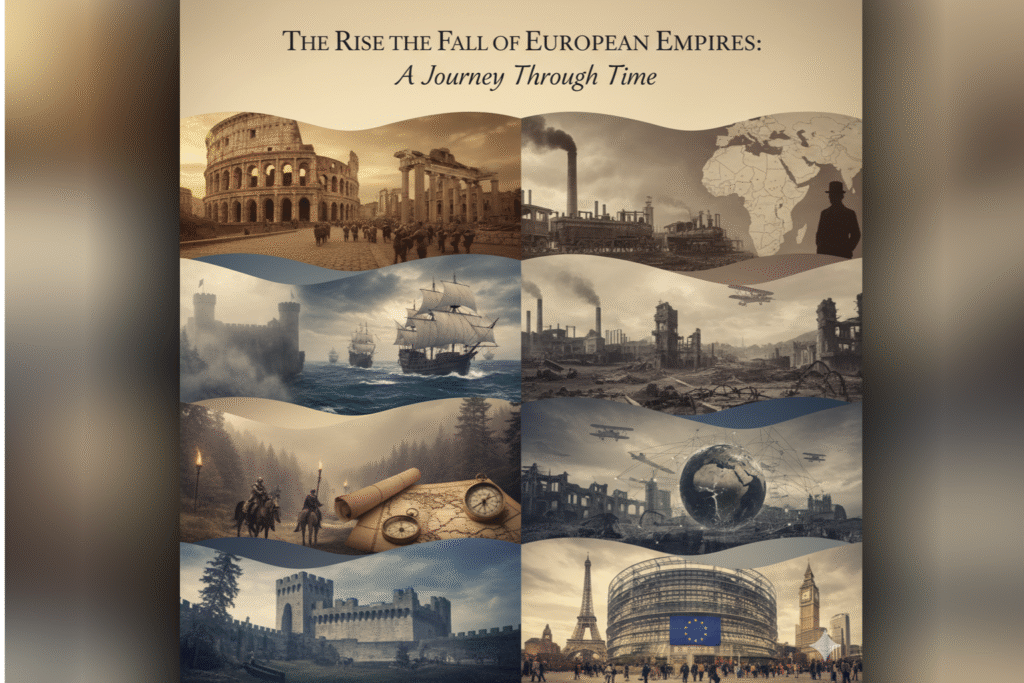The Rise and Fall of European Empires: A Journey Through Time
Europe’s history lays out this tangled story of building up huge empires and then seeing them crumble over time. It follows how those European powers grew and changed through the years. Their big dreams left marks on the whole world that still matter today.
The story usually kicks off with the Roman Empire. That started as a small town by the Tiber River. Over time, it swallowed up most of Europe, parts of North Africa, and some areas in Asia. The Romans came up with strong roads that lasted forever, and their laws still shape how governments work now. Their language roots feed into a lot of what people speak in Europe. Studies point to Rome as a prime example of running things well and building amazing structures. Still, growing so big opened up weak spots. Things fell apart inside, wars dragged on forever, and outsiders kept pushing in. By 476 AD, the western part of the empire broke down completely. That kicked off what folks call the Middle Ages. Modern experts see it more as a shift from one era to another, not just dark times with nothing happening.
After Rome fell apart, Europe split into all sorts of small kingdoms and groups of tribes. The drive to control everything did not go away, though. New players rose up, like the Franks in one area and the Byzantine Empire holding on in the east. Things kept moving, and bigger countries started forming, such as England, France, and Spain. The Holy Roman Empire tried to pull power back to the center. It stayed more of a dream than a real solid thing, in the end. People rebuilt their ways of living bit by bit, even with fights breaking out all the time. All that set the stage for how Europe looks in the history books we know.
Then came the Age of Exploration, and that changed everything by pushing out to claim lands far away. Portugal and Spain led the way with ships heading into unknown waters. Gold and silver pouring in from the Americas gave Spain a quick boost in wealth. Portugal built up a network of colonies that reached from South America all the way to South Asia. But that kind of power did not last long. Other countries jumped in to grab their share.
Britain, France, and the Dutch Republic ramped up the rivalry soon enough. Sea paths linked Europe to Africa, Asia, and the Americas. Trading goods like spices and raw materials, along with the sad trade in people, brought in riches like never before. That wealth came with a lot of selfishness, too. The British Empire grew so huge that it covered lands in different time zones. It controlled places from India to Australia, Canada, and down in southern Africa. Millions of people under all kinds of conditions fell under its rule.
France pushed its empire harder in the early 1800s, especially with Napoleon Bonaparte leading the charge. His armies took over much of Europe. They spread ideas from the Enlightenment about freedom and equality, even if he crowned himself emperor. But defeat hit fast. The brutal cold in Russia wiped out his troops. Then the Battle of Waterloo finished him off in 1815. His influence hung around, anyway. Those wars shook up borders and ways of thinking all over the continent.
The 1800s brought industrialization that flipped the whole scene. Factories and machines made Europe the top dog in money matters. The old empires went after resources without holding back. The rush to divide up Africa showed that side clearly. European countries grabbed chunks of land, paying little attention to the people already living there. This period brings out a hard truth about moving forward. Progress often carried heavy costs for humans and morals alike.
The 1900s brought disasters that shook everything. Two world wars started right in Europe and wrecked buildings and broke apart the empires. Land got shuffled around fast. After the second war ended, colonies started breaking free one after another. Europe’s hold on the world slipped away for good.
Instead of just fading out, Europe adjusted. Old enemies built ties after the fighting. From the ruins came the European Union. It pulled countries together that had spent so long at each other’s throats.
Thinking back on these empires shows more than just taking over lands. They highlight how people chase power, come up with new ideas, and link up across distances. The ups and downs prove nothing lasts forever. What they left behind sticks around strong.
Places today bring those old stories to life in clear ways. Ruins around Rome, old ship docks in London, lit-up streets in Paris, they all echo back. The weight of what happened before keeps coming through. Europe’s story keeps going, full of changes.


